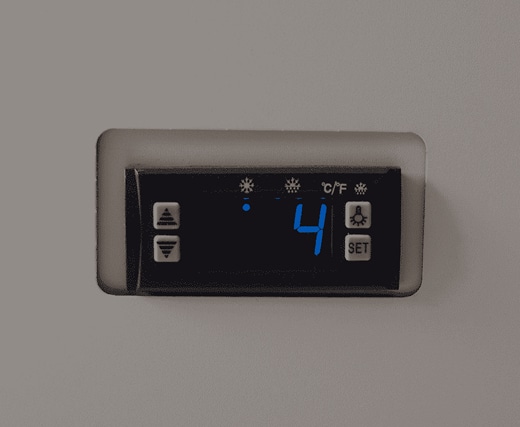Why should you upgrade to energy-efficient refrigeration?
Older fridges use refrigerants such as HFCs (hydrofluorocarbon), which have a high global warming potential (GWP) and are being phased down by the Australian government through the Department of Climate Change, Energy, the Environment and Water (DCCEEW) under the Ozone Protection and Synthetic Greenhouse Gas Management Act 1989 and associated regulations.
Repair costs for these systems have gone up as HFC refrigerants become more expensive, encouraging the transition to natural gases. Older refrigeration units use more energy, meaning they cost more to run, they also require more maintenance to keep them running at an optimal standard and safety. This is not just because of their advancing age, but also because parts are becoming less accessible, and technicians are focusing their training and workforce on their newer, more energy-efficient counterparts.
Should you replace your refrigeration unit?
You should consider replacing your fridge or freezer if:
– It uses a phased-down refrigerant
– It is more than 10 years old
– It is in poor condition, damaged and/or corroded
– It’s a domestic unit designed for residential environments
– Your needs have changed, and a smaller or larger unit would be more suitable
We’d be happy to provide information on how much money your business could save by switching to energy-efficient refrigeration. You can contact our friendly team to discuss your needs today.
How to know if a fridge is energy-efficient
Features like double glazed and self-closing doors, electronic temperature controls, LED lighting, low-GWP refrigerants, and automatic night blinds all help to reduce energy consumption.
If a refrigerator or freezer is ten years or older, it’s very likely that it uses older-style refrigerants (high-GWP) which will reduce its energy efficiency. It’s important to mention that fridges that run on these older-style refrigerants (HFCs) are still available for purchase so it’s best to check before you buy.
Consider your needs first when choosing a commercial fridge and always compare like-for-like products. For example, glass doors generally use more energy than solid doors, so compare units of a similar size and design, and choose the option that best suits your needs.
Check the specs:
- GEMS Star Rating – The more stars, the more energy-efficient the unit is. You can read more about the GEMS Star Rating system here.
- Refrigerant type – Phased-out refrigerants include CFCs and HCFCs while HFCs are currently being phased down due to their higher global warming potential (GWP).
- Energy consumption – This tells you how much energy is consumed per hour, shown as kWh, a helpful spec to calculate your running costs.
5 benefits of using energy-efficient commercial refrigeration
1. Cost savings – Reducing your energy bills and operating costs means increased profits and more money to invest in other parts of your business.
2. Environmental sustainability – Energy-efficient fridges produce a smaller carbon footprint and have less impact on the environment.
3. Improved performance – Newer technologies in refrigeration have produced fridges that maintain consistent, safe temperatures. In addition to using less power, energy-efficient fridges keep your food safe and ready for service which can result in reduced food waste and ensure compliance with food safety requirements.
4. Enhanced brand reputation – With an increasing expectation for businesses to display corporate social responsibility, demonstrating your commitment to sustainability in any way will appeal to more environmentally conscious customers.

5. Compliance with Australian energy-efficiency standards and targets – Rest assured that your energy-efficient fridge meets the Australian testing standards and that your fridge runs safely (e.g. maintaining the right internal temperature) and is compliant with food safety regulations.
At Bromic Refrigeration we offer a range of efficient, low-impact products that use Natural Refrigerant technology (hydrocarbons). By choosing energy-efficient equipment, you can enjoy peace of mind, knowing that your equipment meets Australian energy-efficiency standards such as GEMS and MEPS, while also saving you money through lower running costs. You can find Natural Refrigerant units here.
Government incentives around energy-efficiency
To encourage Australian businesses to invest in energy-efficient commercial refrigeration and to help simplify the transition, the Australian government offers incentives and rebates. You can read more about them here or follow the links below to see if they apply to you:
- Queensland Business Energy Saving & Transformation Rebates
- NSW Energy Savings Scheme (ESS)
- Victorian Energy Upgrade (VEU)
- ACT Sustainable Business Program
- Emissions Reduction Fund (grants)
- SA Retailer Energy Productivity Scheme (REPS)
Real life ROI example when upgrading to energy-efficient refrigeration
Café owner, Miranda has used her drinks display fridge for eight years. Although the fridge is still working, Miranda wants to increase her items per sale by encouraging customers to purchase drinks on-the-go, in addition to their coffee or meal. She determines her new fridge requirements to be a large, 2-door fridge with maximum space capacity for drinks with a glass door so customers can see the products. Here is a comparison based on the upgrade of her drink fridge:








